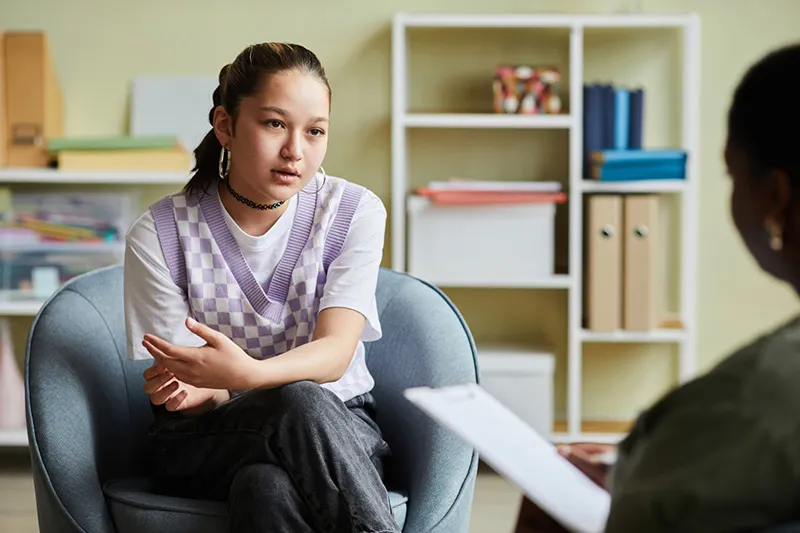Over the past two decades in my clinical practice, I have had the privilege of working with hundreds of adolescents navigating anxiety, depression, and the everyday challenges of growing up in a rapidly changing world. One approach that consistently stands out for its effectiveness is Cognitive Behavioral Therapy (CBT), a structured, evidence-based approach to teen mental health counselling that helps young people build lifelong emotional skills.
In this article, I will unpack what CBT is, why it works so well for teens, and what a typical course of CBT looks like from both the therapist’s and the teenager’s perspective.
Understanding Teen Mental Health Today
The landscape of adolescent mental health has shifted dramatically in recent decades. Studies from the Canadian Mental Health Association and Statistics Canada show that rates of anxiety, depression, and stress-related disorders among teens have steadily increased since the pandemic. Social media pressure, academic expectations, family stress, and global uncertainty all play a role.
Teenagers today are more self-aware and open about their struggles, but they often lack practical tools to manage difficult thoughts and emotions. That’s where CBT comes in. It’s not a quick fix, but a structured learning process that empowers teens to understand and reshape their own mental patterns.
What Is Cognitive Behavioral Therapy (CBT)?
CBT is a structured, goal-oriented form of psychotherapy developed in the 1960s by psychiatrist Dr. Aaron Beck. It is based on a simple yet powerful principle:
Our thoughts, emotions, and behaviors are interconnected. Change one, and you can change the others.
In CBT, therapists work with clients to identify unhelpful patterns of thinking, like “I’m not good enough,” “Everyone hates me,” or “I’ll fail anyway,” and replace them with more balanced, realistic ones.
For teens, this approach is particularly effective because it focuses on skill-building rather than abstract analysis. Adolescents often appreciate CBT’s practical, action-based style since it gives them tools they can use right away in daily life.
How CBT Works for Teens
Let us break down how CBT is typically applied in teen mental health counselling.
1. Building a Collaborative Relationship
The first step in CBT is establishing trust. Teens are perceptive and can quickly tell whether a therapist is being genuine. A good CBT therapist meets them where they are, using empathy, validation, and curiosity instead of judgment.
Once rapport is built, the therapist and client identify specific goals together such as reducing panic attacks, managing social anxiety, improving motivation, or challenging negative self-image.
2. Identifying Negative Thought Patterns
The therapist helps the teen recognize automatic thoughts – the instant interpretations that pop up in stressful situations.
For example:
- A friend does not respond to a text → “They must not like me.”
- A poor grade on a test → “I’m stupid.”
These thoughts often feel true in the moment, but CBT teaches that thoughts are not facts. By learning to observe and question them, a person starts to regain control over their emotional responses.
One key technique here is keeping track of negative thoughts and triggers, often called thought monitoring. One might keep a “thought diary” to track situations that trigger strong emotions and the beliefs that accompany them. This awareness and reflection becomes the foundation for change.
3. Cognitive Restructuring: Challenging and Reframing Thoughts
Once negative thought patterns are identified, the therapist guides the client through cognitive restructuring, a process of testing and reframing unhelpful thoughts.
For example, if a teen believes, “I always mess things up,” the therapist might ask:
- “What is the evidence for and against that thought?”
- “Have there been times you succeeded?”
- “What would you say to a friend who thought that about themselves?”
This process draws from Beck’s Cognitive Theory of Depression, which emphasizes that negative thinking styles such as overgeneralization, catastrophizing, and all-or-nothing thinking maintain emotional distress.
Through repeated practice, teens learn to replace distorted thoughts with balanced, compassionate, and realistic perspectives.
4. Behavioral Activation and Exposure
While CBT starts with thoughts, it is equally focused on behavioral change. Many teens with anxiety or depression withdraw from activities that once brought joy. CBT introduces behavioral activation, encouraging gradual re-engagement in positive or meaningful actions such as going for a walk, attending a social event, or practicing a hobby.
For anxiety disorders or phobias, CBT often includes exposure therapy, a gradual, supported process of facing fears in a controlled way. For instance, a teen with social anxiety might start by saying hello to a classmate, then progress to joining a group activity, eventually presenting in front of peers.
Exposure helps retrain the brain’s fear response and builds confidence through small, repeated successes.
5. Developing Coping and Problem-Solving Skills
CBT for teens integrates tools that promote emotional regulation and resilience. Common techniques include:
- Mindfulness and grounding exercises to reduce rumination
- Relaxation training for physiological symptoms of anxiety
- Structured problem-solving models that help break overwhelming issues into manageable steps
These skills not only alleviate current distress but also serve as lifelong resources for handling future challenges.
Why CBT Works So Well for Teens
CBT aligns beautifully with the developmental stage of adolescence. During the teen years, the brain is undergoing rapid growth in areas responsible for reasoning, impulse control, and emotional regulation, especially the prefrontal cortex.
CBT leverages this natural neuroplasticity by teaching metacognitive skills, or the ability to think about one’s own thinking. Teens begin to see that emotions, though powerful, are temporary and influenced by perception.
Furthermore, CBT appeals to teens’ desire for autonomy. Instead of feeling “talked at,” they are active participants in their own healing. They learn not just what to change, but how to change it.
Evidence Supporting CBT for Teen Mental Health Counselling
CBT is one of the most researched psychotherapies in the world. Meta-analyses consistently show its effectiveness for adolescents struggling with:
- Anxiety disorders (panic, phobias, social anxiety)
- Depression
- Obsessive-Compulsive Disorder (OCD)
- Post-Traumatic Stress Disorder (PTSD)
- Behavioral and adjustment issues
Numerous studies specifically focused on adolescents demonstrate its strong effectiveness for anxiety, depression, and behavioral issues.
- A meta-analysis by James et al. (2015) in the Cochrane Database of Systematic Reviews found that CBT significantly reduced anxiety symptoms in children and adolescents compared to waitlist or placebo, with sustained improvements at follow-up.
- A randomized controlled trial by Clarke et al. (1999) showed that group-based CBT for adolescent depression led to lasting symptom reduction and improved functioning, outperforming supportive counselling.
- More recently, Weisz et al. (2017) analyzed over 50 years of data and confirmed that CBT produces moderate to strong effects for youth emotional disorders, making it one of the most evidence-supported treatments for teens.
According to a 2021 review in the Canadian Journal of Psychiatry, CBT demonstrates moderate to strong effect sizes across these conditions, often outperforming medication alone for mild to moderate symptoms.
Many Canadian school-based and community programs, such as Strong Minds, Strong Kids and Mind Your Mind, integrate CBT principles into youth resilience training, highlighting its accessibility and adaptability.
What Parents Should Know
Parents are an essential part of a teen’s journey through therapy. When a young person starts CBT, the process can feel unfamiliar at first, and your support can make all the difference. It is natural for parents to want to “fix” what feels broken, but in CBT, the goal is to help teens develop confidence in their own ability to manage thoughts and emotions. Supporting your teen does not mean taking over the process. It means creating an environment at home that helps the skills from therapy take root and grow.
Parents play a key role in supporting their teen’s CBT journey by fostering reflection rather than perfection, modeling flexibility and self-compassion, and respecting their teen’s privacy and independence. Encouraging open, judgment-free conversations helps teens feel trusted, while small acts like sharing mindful moments or practicing calm routines at home reinforce what they learn in therapy. Instead of controlling the process, parents can collaborate by showing interest in how therapy feels rather than focusing on outcomes. When invited, participating in family sessions can strengthen communication, deepen understanding, and create a more supportive environment for lasting emotional growth.
A Glimpse Inside a CBT Session
Every therapist’s approach is unique, but a typical 50-minute CBT session for teens might include:
- A brief check-in on mood and weekly progress
- Review of the thought diary or assigned exercises
- Cognitive restructuring or skill-building activities
- Role-playing or problem-solving real-life scenarios
- Setting homework, which are small, achievable actions to practice new skills
Therapy is collaborative and time-limited; most CBT programs run eight to twenty sessions. The goal is not dependency but self-efficacy, helping teens become their own therapists over time.
In the heart of every adolescent struggle lies potential, potential for growth, understanding, and resilience. Cognitive Behavioral Therapy provides a roadmap for unlocking that potential. It teaches teens to recognize the stories they tell themselves, challenge unhelpful patterns, and write new ones rooted in compassion and truth.
In a world that often feels overwhelming, CBT gives young people what they need most: a sense of agency. And as any parent, teacher, or clinician will tell you, when a teen learns to think differently, they begin to live differently.
If you are considering CBT or teen mental health counselling for your child, know that help is available across Canada through private practices, school-based programs, and community mental health services. With the right support at Rocky Mountain Psychological Services, your teen can learn not just to cope, but to thrive.
References
James, A. C., James, G., Cowdrey, F. A., Soler, A., & Choke, A. (2015). Cognitive behavioural therapy for anxiety disorders in children and adolescents. Cochrane Database of Systematic Reviews, 2.
Clarke, G. N., Rohde, P., Lewinsohn, P. M., et al. (1999). Cognitive-behavioral treatment of adolescent depression: Efficacy of acute group treatment and booster sessions. Journal of the American Academy of Child & Adolescent Psychiatry, 38(3), 272–279.
Weisz, J. R., Kuppens, S., Ng, M. Y., et al. (2017). What five decades of research tells us about the effects of youth psychological therapy: A multilevel meta-analysis and implications for science and practice. American Psychologist, 72(2), 79–117.


